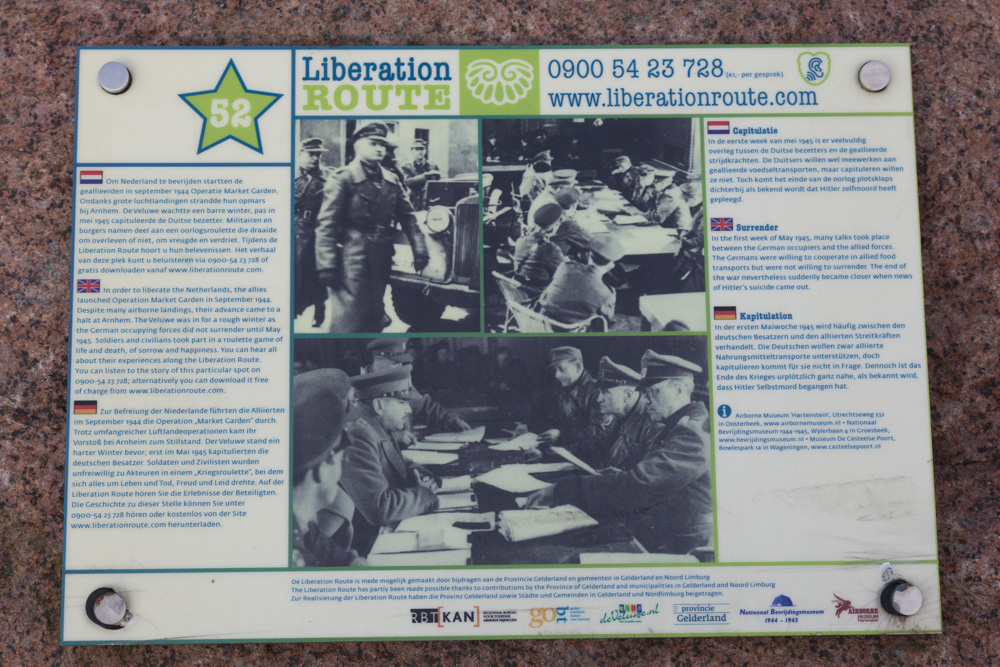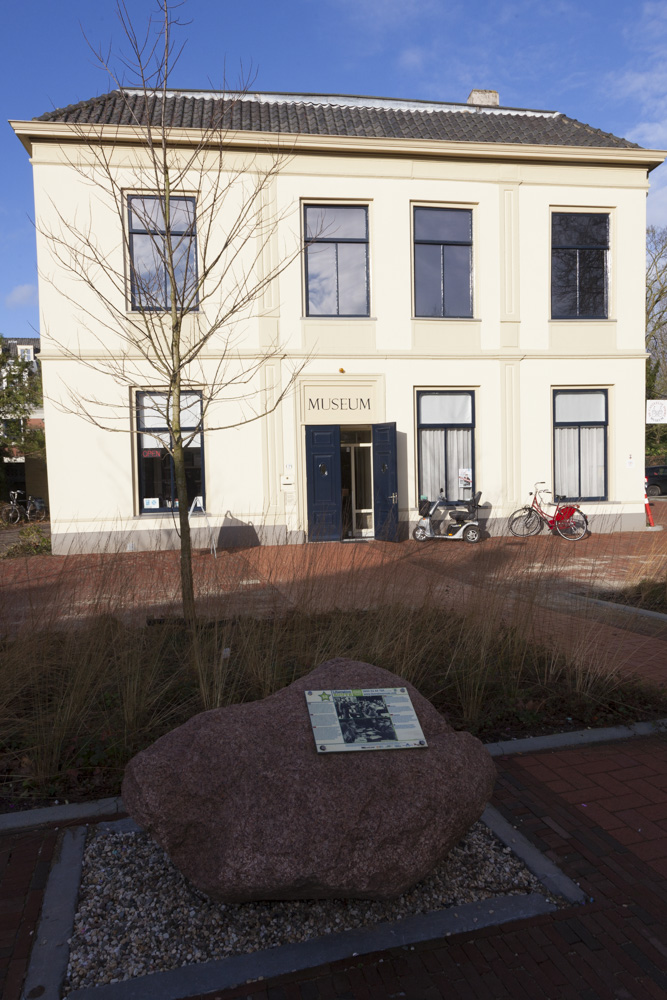Liberation Route Marker 052: The German capitulation in Wageningen
The German capitulation in Wageningen
In the first week of May 1945, negotiations took place between the Germans and the Allied forces. The Germans were willing to allow food transports, but were not yet prepared to surrender. The end of the war nevertheless suddenly became closer when news of Adolf Hitler's suicide came out. On 6 May German general Blaskowitz signed the capitulation in Wageningen.
On 4 May 1945 Field Marshal Montgomery accepted the official surrender of the German army in North-West Europe at his headquarters on Lüneburger Heath in Germany. Then, on 5 May 1945, while Germany had already officially surrendered, General Foulkes, commander of the 1st Canadian Army, decided to draw up a separate surrender document. He summoned the German general Blaskowitz to Hotel de Wereld in Wageningen to sign the capitulation.
Initially, Blaskowitz sent his chief of staff, lieutenant-general Reichelt. However, he was told that this was not sufficient and that Blaskowitz had to come himself. At four o'clock that afternoon, Blaskowitz came to the hotel. Prince Bernhard, acting as commander-in-chief of the Dutch Interior Forces was also present at the meeting, along with a large number of reporters and cameramen.
A detailed document of surrender was presented to Blaskowitz who asked for 24 hours delay in the signing of the document in which he could asses if he could meet all of the demands stipulated in the document. Blaskowitz returned the next day (6 May) to sign the official surrender of all German forces in the Netherlands. After five years of occupation the country was free once again. Although the war was officially over, a number of unfortunate incidents still took place. Some German forces refused to lay down their arms and clashed with member of the Dutch Interior Forces or members of the resistance. In Amsterdam such an occurrence led to the death of 19 civilians.
Audiospot - The German capitulation in Wageningen
Liberation Route Europe is a certified Cultural Route of the Council of Europe. With hundreds of sites and stories in nine European countries, the route links the main regions along the advance of the Allied Forces in 1943-1945.
The entire route consists of themed routes that can be travelled by by hiking, walking, cycling and car. These routes pass numerous historical and interesting sites and tell stories from a multitude of perspectives that were important in the final phase of World War II.
Many routes feature listening spots, offering the opportunity to listen to a historical story at a location. In addition, many ‘Vectors of Memory’ have been placed, indicating that the passer-by is on one of the Liberation Routes.
The routes can be found on the Liberation Route Europe website or in the app through which many stories can also be listened to.
Do you have more information about this location? Inform us!
Source
- Text: TracesOfWar & Liberation Route Europe
- Photos: Arjan Vrieze
Nearby
Museum
- The Liberation Hall Museum "De Casteelse Poort" Wageningen - Wageningen
- Visitor Center And Museum Dutch War Cemetery Grebbeberg - Rhenen
- Betuws War Museum "The Island" 1944-1945 - Heteren
Point of interest
- Hotel De Wereld (Hotel the World) Wageningen - Wageningen
- Noda Farmhouse Rhenen - Rhenen
- Information Sign Evert Wilhelmus Hoksbergen - Randwijk
Monument
- Memorial Jewish Resistance Wageningen - Wageningen
- Memorials Population Registry on Town Hall Wageningen - Wageningen
- Memorial Window Liberation 1940-1945 - Wageningen
Cemetery
- Dutch War Graves RC Cemetery De Leeuwer Enk - Wageningen
- Commonwealth War Graves General Cemetery De Leeuwer Enk Wageningen - Wageningen
- Jewish War Graves New Jewish Cemetery Wageningen - Wageningen
Remembrance Stone
- Memorial Stones Bowlespark 2 - Wageningen
- Memorial stones Maurice and Yetty Elzas - Wageningen
- Stumbling Stones Bovenweg 25 - Bennekom
Fortification
- Kolff-Casemate KLF001 Maneswaard - Opheusden
- Grebbe Line - S3 Casemate GLZ12 - Rhenen
- Grebbe Line - PAG-Casemate P11 Grebbesluis - Rhenen






